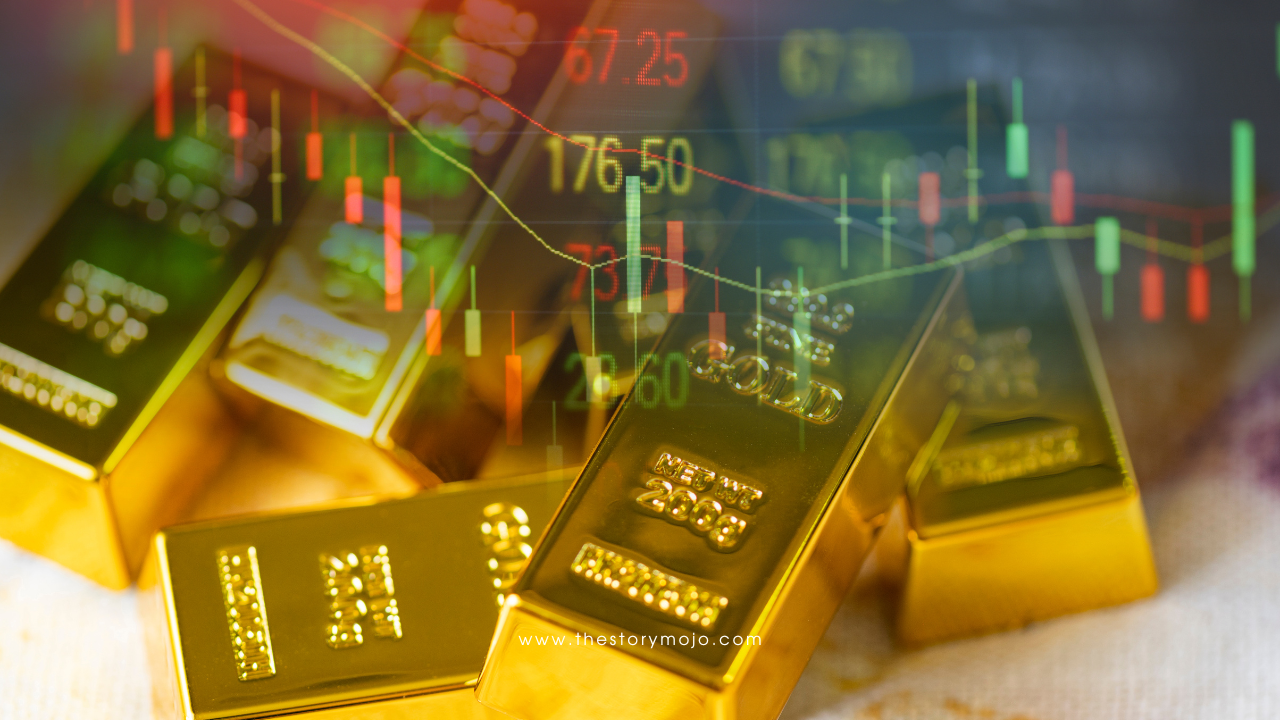

Table of Contents
ToggleGold Price Changes Over the Last Decade and Their Impact on Global Economies
Over the past ten years, from 2015 to 2025, gold prices have experienced significant fluctuations, driven by a complex interplay of economic, geopolitical, and market-specific factors. As a safe-haven asset, gold’s value often moves countercyclically to global economic conditions, rising during periods of uncertainty and stabilizing or declining when confidence in traditional financial markets grows. This article explores the trajectory of gold prices over the last decade, analyzing the key drivers behind these changes and their profound impacts on the economies of various countries, including major producers, consumers, and financial hubs.
Gold Price Trends: 2015–2025
2015–2019: A Period of Range-Bound Stability
In 2015, gold prices were relatively subdued, averaging around $1,160 per troy ounce. The global economy was recovering from the 2008 financial crisis, and investor confidence in equities and other riskier assets reduced demand for gold. The U.S. dollar strengthened during this period, further pressuring gold prices, as gold is typically denominated in dollars and becomes more expensive for foreign buyers when the dollar appreciates. Prices fluctuated between $1,100 and $1,300 through 2019, with occasional spikes driven by geopolitical tensions, such as U.S.-China trade disputes and Brexit uncertainties.
By mid-2019, gold began to climb, breaching $1,500 per ounce. This uptick was fueled by a softening U.S. dollar, rising geopolitical issues, and a slowdown in global economic growth. Central banks, particularly in emerging markets like China and Russia, increased gold purchases to diversify reserves away from dollar-dominated assets, signaling a shift in global financial strategies.
2020–2021: The Pandemic Surge
The COVID-19 pandemic in 2020 marked a turning point for gold prices. As economies locked down and stock markets plummeted, investors flocked to gold as a hedge against uncertainty. Gold reached a record high of $1,769.64 per ounce in 2020, with prices peaking above $2,000 in August. The surge was driven by unprecedented monetary stimulus, near-zero interest rates, and fears of inflation as governments and central banks pumped trillions into economies to mitigate the pandemic’s impact.
In 2021, gold prices moderated slightly, averaging around $1,800 per ounce. The rollout of vaccines and economic reopening efforts restored some investor confidence, reducing demand for safe-haven assets. However, persistent inflation concerns and supply chain disruptions kept gold prices elevated compared to pre-pandemic levels.
2022–2023: Geopolitical Tensions and Inflation
The Russia-Ukraine conflict, which began in 2022, reignited gold’s appeal as a safe-haven asset. Prices surged to around $2,000 per ounce early in the year, driven by fears of global instability and sanctions on Russia, a major gold producer. Central banks continued their buying spree, with global purchases exceeding 1,000 tonnes annually, the highest since 1950. Inflation, particularly in the U.S., reached multi-decade highs, prompting the Federal Reserve to raise interest rates aggressively. While higher rates typically depress gold prices by increasing the opportunity cost of holding non-yielding assets, gold’s role as an inflation hedge kept demand robust.
By 2023, gold prices averaged $1,943.08 per ounce, reflecting ongoing economic uncertainty and central bank diversification efforts. Emerging market central banks, led by China and India, significantly increased their gold reserves, further supporting prices.
2024–2025: Record Highs Amid Trade Wars and Tariffs
In 2024, gold prices continued their upward trajectory, driven by a combination of geopolitical and economic factors. The re-election of Donald Trump as U.S. President in November 2024 introduced new uncertainties, particularly around his aggressive tariff policies. By April 2025, gold hit an all-time high of over $3,160 per ounce, propelled by Trump’s “Liberation Day” tariffs, including 10% blanket tariffs on imports and higher rates for countries like China and the EU. Additional tariffs on steel, aluminum, and automotive sectors further fueled economic uncertainty, boosting gold demand.
Other factors contributing to the 2025 rally included a weakening U.S. dollar, sticky inflation, and increased safe-haven demand. Central banks, particularly the People’s Bank of China, added significant gold to their reserves, with purchases of 5 tonnes in November 2024 and 10 tonnes in December. As of April 10, 2025, gold prices stood at approximately $3,172.85 per ounce, reflecting a 22.48% increase since the start of the year.
Drivers of Gold Price Changes
Several key factors have shaped gold price movements over the past decade:
- Geopolitical Instability: Events like the Russia-Ukraine war, U.S.-China trade tensions, Middle East conflicts, and Trump’s tariff policies have driven investors to gold as a safe-haven asset.
- Monetary Policy: Near-zero interest rates and quantitative easing during the pandemic boosted gold prices, while subsequent rate hikes introduced volatility. Gold’s non-yielding nature makes it sensitive to real interest rates.
- Inflation and Currency Movements: Gold’s role as an inflation hedge became prominent as global inflation surged post-2020. A weaker U.S. dollar in 2024–2025 made gold more attractive to foreign buyers.
- Central Bank Purchases: Emerging market central banks, seeking to diversify away from the U.S. dollar, have been major buyers, reducing available supply and signaling confidence in gold.
- Supply and Demand Dynamics: Stable global gold production (around 3,000 metric tons annually) and rising demand from jewelry, technology, and investment sectors have supported price increases.
- Investor Sentiment: The rise of gold-backed ETFs and increased retail investment, particularly in China and India, have amplified demand during turbulent times.
Impact on Country Economies
The fluctuations in gold prices have had varied impacts on economies worldwide, depending on their roles as producers, consumers, or financial hubs. Below, we examine the effects on key countries and regions.
Major Gold-Producing Countries
- China:
- Production and Economy: As the world’s largest gold producer, China benefits from higher gold prices through increased export revenues and mining profits. However, domestic demand for gold in jewelry and investment often outpaces production, making China a net importer.
- Economic Impact: Rising gold prices have bolstered China’s foreign exchange reserves, particularly as the People’s Bank of China increased gold holdings to hedge against dollar depreciation and potential tariff-related trade disruptions. However, higher prices have strained consumers, particularly in the jewelry sector, which accounts for a significant portion of global demand (57% alongside India).
- Policy Implications: China’s central bank has used gold to diversify reserves, reducing reliance on the U.S. dollar amid trade tensions. This strategy has strengthened its economic resilience but increased domestic gold prices, impacting affordability for retail investors.
- Australia:
-
- Production and Economy: Australia, with the largest mine reserves globally, has seen significant economic benefits from gold price increases. Gold exports, a key component of Australia’s trade balance, surged in value, contributing to GDP growth.
- Economic Impact: Higher gold prices have supported mining communities and regional economies, creating jobs and infrastructure investment. However, rising production costs, which reached $1,300 per ounce by 2023, have squeezed margins for some miners.
- Policy Implications: The Australian government has leveraged gold export revenues to fund renewable energy and infrastructure projects, but environmental regulations and labor costs pose challenges to sustaining production growth.
- Russia:
- Production and Economy: Russia, a top gold producer, has used gold to shield its economy from Western sanctions following the Ukraine conflict. Higher prices have increased the value of its gold reserves, providing a buffer against economic isolation.
- Economic Impact: Gold sales have helped stabilize the ruble and fund government spending, particularly in defense. However, sanctions have limited access to global markets, forcing Russia to redirect gold exports to countries like China and India.
- Policy Implications: Russia’s central bank has prioritized gold accumulation, viewing it as a strategic asset to counter dollar-based financial systems. This has strengthened its geopolitical leverage but exposed the economy to gold price volatility.
- South Africa:
- Production and Economy: Once a dominant gold producer, South Africa’s output has declined due to aging mines and high costs. Rising gold prices have provided a lifeline to the industry, boosting export revenues.
- Economic Impact: Higher prices have supported mining jobs and government revenues through royalties and taxes. However, structural challenges, such as power shortages and labor disputes, have limited the sector’s ability to capitalize fully on price gains.
- Policy Implications: South Africa has used gold revenues to address fiscal deficits, but the economy remains vulnerable to global price swings and domestic inefficiencies.
Major Gold-Consuming Countries
- India:
- Consumption and Economy: India, the second-largest gold consumer globally, has a deep cultural affinity for gold, particularly in jewelry and investment. Gold prices rose from Rs. 26,343 per 10 grams in 2015 to Rs. 77,000 in 2024, a 192% increase.
- Economic Impact: Higher gold prices have strained household budgets, as gold is a traditional wedding and festival purchase. The jewelry sector, a significant employer, has faced reduced demand due to affordability issues. However, gold’s role as an inflation hedge has attracted institutional and retail investors, supporting financial markets.
- Policy Implications: The Indian government has imposed higher import duties to curb gold’s impact on the trade deficit, encouraging domestic recycling and digital gold investments. Rising prices have also spurred smuggling, complicating enforcement efforts.
- United States:
- Consumption and Economy: The U.S., holding the largest gold reserves globally (over 8,000 tonnes), uses gold primarily for investment and industrial purposes. Rising prices have increased the value of its reserves, enhancing economic stability.
- Economic Impact: Higher gold prices have benefited U.S.-based gold mining companies and investors holding gold-backed ETFs. However, they have also signaled economic uncertainty, particularly in 2024–2025, as tariffs raised inflation fears and eroded consumer confidence.
- Policy Implications: The U.S. Federal Reserve monitors gold prices as an inflation indicator but does not actively manage reserves like emerging markets. Proposals to audit Fort Knox gold holdings, raised by figures like Elon Musk, reflect public interest in gold’s role amid economic turbulence.
- European Union:
- Consumption and Economy: EU countries, particularly Germany and France, hold significant gold reserves but consume gold primarily in investment and luxury goods. Rising prices have increased reserve values, supporting eurozone stability.
- Economic Impact: Higher gold prices have driven demand for gold-backed financial products, boosting asset management sectors. However, they have also raised costs for jewelry and technology industries, impacting competitiveness.
- Policy Implications: The European Central Bank maintains gold as a reserve asset but focuses on monetary policy over active gold management. Tariff-related trade disruptions in 2025 have prompted some EU countries to consider increasing gold reserves as a hedge.
Financial Hubs and Global Markets
- United Kingdom:
- Role and Economy: London remains a global gold trading hub, with the London Bullion Market Association (LBMA) setting benchmark prices. Rising gold prices have increased trading volumes and revenues for financial institutions.
- Economic Impact: Higher prices have supported the UK’s financial services sector, a key economic driver. However, Brexit-related uncertainties and tariff impacts have tempered broader economic benefits.
- Policy Implications: The UK has maintained stable gold reserves, using price gains to bolster fiscal credibility. However, reliance on financial services exposes the economy to gold market volatility.
- Switzerland:
- Role and Economy: Switzerland, a major gold refining and storage hub, benefits from price increases through higher refining margins and vaulting fees.
- Economic Impact: The gold trade supports Switzerland’s reputation as a financial safe haven, attracting capital inflows. However, rising prices have increased costs for its watchmaking and jewelry industries.
- Policy Implications: Switzerland’s neutral stance and robust gold infrastructure ensure economic stability, but global trade tensions could disrupt supply chains.
Broader Economic Implications
- Inflation and Monetary Policy:
- Rising gold prices often signal inflationary pressures, prompting central banks to adjust interest rates. In 2022–2023, gold’s strength reflected global inflation concerns, influencing tighter monetary policies that slowed economic growth in some regions.
- In 2025, persistent inflation, exacerbated by tariffs, has kept gold prices elevated, complicating central banks’ efforts to balance growth and price stability.
- Trade Balances:
- For gold-importing countries like India and China, higher prices have widened trade deficits, as gold accounts for a significant share of imports. This has pressured currencies like the Indian rupee, requiring policy interventions.
- Gold-exporting countries, such as Australia and Canada, have seen improved trade balances, supporting currency stability and economic growth.
- Wealth Distribution:
- Rising gold prices have benefited investors and countries with large gold reserves, increasing wealth concentration in financial hubs and emerging markets. However, they have strained consumers in gold-dependent cultures, exacerbating inequality.
- In India, for example, higher prices have made gold less accessible for lower-income households, impacting traditional savings mechanisms.
- Geopolitical Strategies:
- Gold’s role as a non-dollar asset has grown, with countries like China and Russia using it to counter U.S. financial influence. This “de-dollarization” trend has strengthened gold’s strategic importance, influencing global economic alignments.
- Tariff policies in 2025 have accelerated this shift, as affected countries seek gold to mitigate trade disruptions and currency risks.
Challenges and Opportunities
Challenges:
- Volatility Risks: Gold’s sensitivity to geopolitical and economic shifts creates uncertainty for producers and consumers, complicating long-term planning.
- Affordability Issues: In consumer-driven markets like India, rising prices reduce demand, impacting jewelry industries and cultural practices.
- Environmental Costs: Higher prices incentivize mining, raising environmental concerns in countries like South Africa and Australia, where ecological regulations are stringent.
Opportunities:
- Economic Diversification: Gold-producing countries can reinvest revenues into sustainable development, reducing reliance on volatile commodities.
- Financial Innovation: Rising prices have spurred growth in gold-backed ETFs and digital gold products, expanding investment access in countries like India and the U.S.
- Geopolitical Leverage: Countries with large gold reserves can enhance their global influence, using gold as a diplomatic and economic tool.
Conclusion
The past decade has seen gold prices evolve from relative stability to record highs, driven by pandemics, wars, inflation, and trade policies. These changes have reshaped economies worldwide, bolstering producers like China and Australia, challenging consumers in India, and reinforcing gold’s role as a strategic asset for central banks. While higher prices have supported financial stability in some contexts, they have also strained affordability and highlighted inequalities.
As we move forward, gold’s trajectory will likely remain tied to global uncertainties, from trade wars to climate challenges. Countries must navigate these dynamics carefully, balancing economic gains with social and environmental costs. Gold, with its enduring allure, will continue to shape economic narratives, serving as both a safe haven and a mirror of global anxieties.
©2025 thestorymojo.com All rights reserved.






Be the first to leave a comment